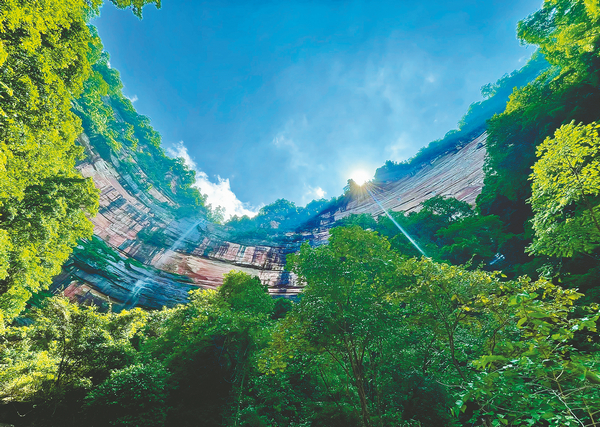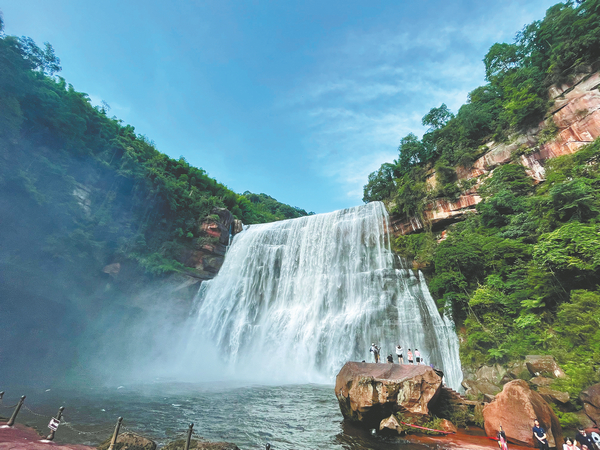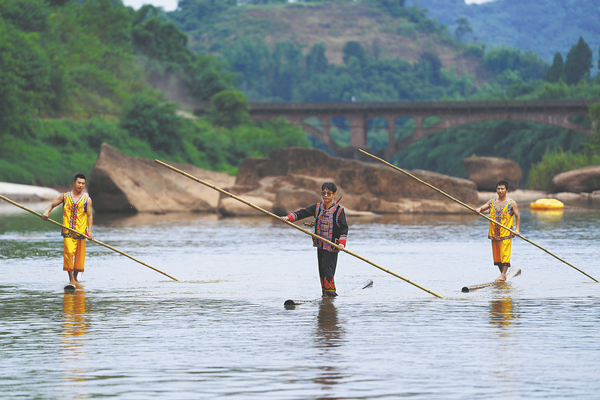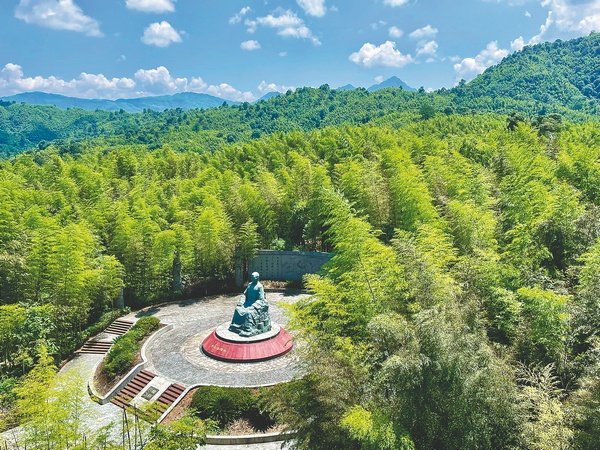The art of drifting along a river on a stem of bamboo becomes one of the province's biggest draws, Qiu Quanlin reports in Chishui, Guizhou.
Standing on a thick bamboo stem floating on the Datong River, a tributary of the Chishui River in Guizhou province, Xiong Bin played the lusheng, a Miao ethnic reed-pipe flute.
Such scenes have become common in Datong township, which lies in a mountainous area in northern Guizhou, as 20-year-old Xiong and other young villagers perform for tourists at the weekend or during holidays.
Originating in northern Guizhou, the tradition of single bamboo drifting requires the practitioner to stand or sit on a stem of bamboo, which is usually 7. 5 to 8 meters long, while performing balancing movements using a thinner strip of bamboo up to 4. 5 meters long.
In addition to the balancing movements, Xiong usually plays the pipes.
"Playing the lusheng and performing other balancing movements on the bamboo stem is part of our efforts to improve the experience for tourists, as we are promoting single bamboo drifting, "says the Miao man.

Foguangyan, or the Buddha Light Rock, a Danxia colorful rock formation in the Chishui Danxia National Geopark. QIU QUANLIN/CHINA DAILYThe unusual practice, listed as national intangible cultural heritage in 2021, was introduced as a competitive event at the 9th National Traditional Games of Ethnic Minorities in 2011.
Xiong says that in the Chishui River area, where bamboo covers the mountains, people used to cross rivers on bamboo stems.
"Traditionally, transportation in our township relied heavily on river channels, as roads were not very convenient, "he says.
The practice arose from the transportation of bamboo by river to nearby Sichuan province and Chongqing. People lashed stems together with small strips of bamboo, creating rafts that they then floated downriver. Xiong says the trouble with this was that the rafts could easily break apart.
"So people would use poles to pull the bamboo back, jumping back and forth frequently. With practice, they became skilled at drifting along rivers on bamboo, "says Xiong.
The bamboo has to be a green moso bamboo, which is more buoyant and lasts longer. Xiong says that green moso is thicker and grows straighter, so it creates less resistance, allowing it to travel faster, and was unbundled in the river for transportation.
"When I first saw people doing single bamboo drifting, I found it very interesting, "he says, adding that he began to learn how to do it himself in 2018.
The practice relies on balance because each stem of bamboo has a different degree of curvature and so finding the point of balance is vital.

A waterfall in Chishui Danxia National Geopark. Chishui, a county-level city in northern Guizhou province, is well-known for its plentiful bamboo and world natural heritage sites. QIU QUANLIN/CHINA DAILYSingle bamboo drifting has gained popularity among youngsters in recent years, thanks to increased efforts by local authorities to promote it.
"We hold training classes every year, so that young people who are interested come and learn, "he says.
Xiong is a member of a single bamboo drifting team led by Peng Gang, who has nearly four decades of experience.
Growing up along the Chishui River, the 54-year-old developed an interest as a child.
"Single bamboo drifting was a common sight when I was young, as villagers used to cross the river on bamboo, "says Peng, who began imitating his elders by jumping on floating bamboo stems for fun.
Peng joined the single bamboo drifting team that was founded in Datong in 2009, practicing in the river for four to five hours every day from May to September.

Xiong Bin(center), a member of the Miao ethnic group, performs single bamboo drifting with two young residents of Chishui on the Datong River, a tributary of the Chishui River. ZHANG XIAO/CHINA DAILY"All the movements that are simple to perform on the shore, such as a forward stroke, a backward stroke, turning around, supporting the pole and manipulating it, place a high demand on physical strength, endurance and balance when done on the water, "he says.
Over time, Peng became highly skilled and was later designated as an inheritor of the tradition.
"Developing an interest is very important. Then you need to practice again and again to become skilled, "he says.
He was forced to step back in 2021, due to age and physical injuries, leaving the water for the land, and he threw himself into training successors.
"Although I can't do it anymore, I will lead this team well and pass on the legacy of single bamboo drifting to young people, "he says.
Over the years, Peng has taught his team a complete set of performances consisting of 20 balancing movements.
As a local intangible cultural heritage performance project, single bamboo drifting is performed for tourists during holidays and at large-scale events, and has been performed around the country on many occasions.
Peng maintains a playful attitude to the practice, saying that this plays an important role in training young people.
"Only those who love it and are willing to experiment can persist and improve their skill, "he says.
He doesn't worry about skill levels, but ways to pass on the tradition.
"I'm really used to playing on bamboo in rivers for fun, and this should be encouraged among young people who are training to do it. "
There are no fixed schedules and training takes place whenever weather conditions allow, and his team includes a dozen local young people, two of whom are women.

A view of the Chishui Bamboo National Forest Park. QIU QUANLIN/CHINA DAILYLuo Qing, a 26-year-old member of the team, started learning when he was in primary school.
"It was really exciting and fun to watch people drifting, so I slowly learned how to do it, "he says.
Learning wasn't easy as he wasn't a good swimmer. "I couldn't even stand on the bamboo, let alone balance. I fell into the water a lot at first, "he adds.
Support from his family encouraged Luo to persist. "My parents were quite supportive, and they encouraged me to learn in my spare time. "
Peng taught him for free. "Peng was very responsible, he taught us how to stand on the bamboo, how to make it move, and how to balance our attitude toward the sport, "he says.
"It takes a lot of time to learn if you really want to be good at standing on a bamboo stem, so you need to be very patient. "
After practicing for more than a decade, Luo now performs for tourists in Datong, which has become a popular destination for its many examples of intangible cultural heritage and tourist offerings.
Datong was traditionally an important river port for trading between the provinces of Guizhou and Sichuan.
Thanks to its plentiful supply of bamboo, it is also famous for bamboo weaving, which is a provincial-level intangible cultural heritage in Guizhou.
"We do not earn much from performing for tourists, we do it because we love it, and we want to demonstrate our intangible cultural heritage to the outside world, "Luo says.
After years of involvement, he has decided to encourage his daughter to learn single bamboo drifting when she grows older.
"Like my parents when I was young, I would like my daughter to learn. After all, single bamboo drifting is the legacy of our ancestors, "he says.



